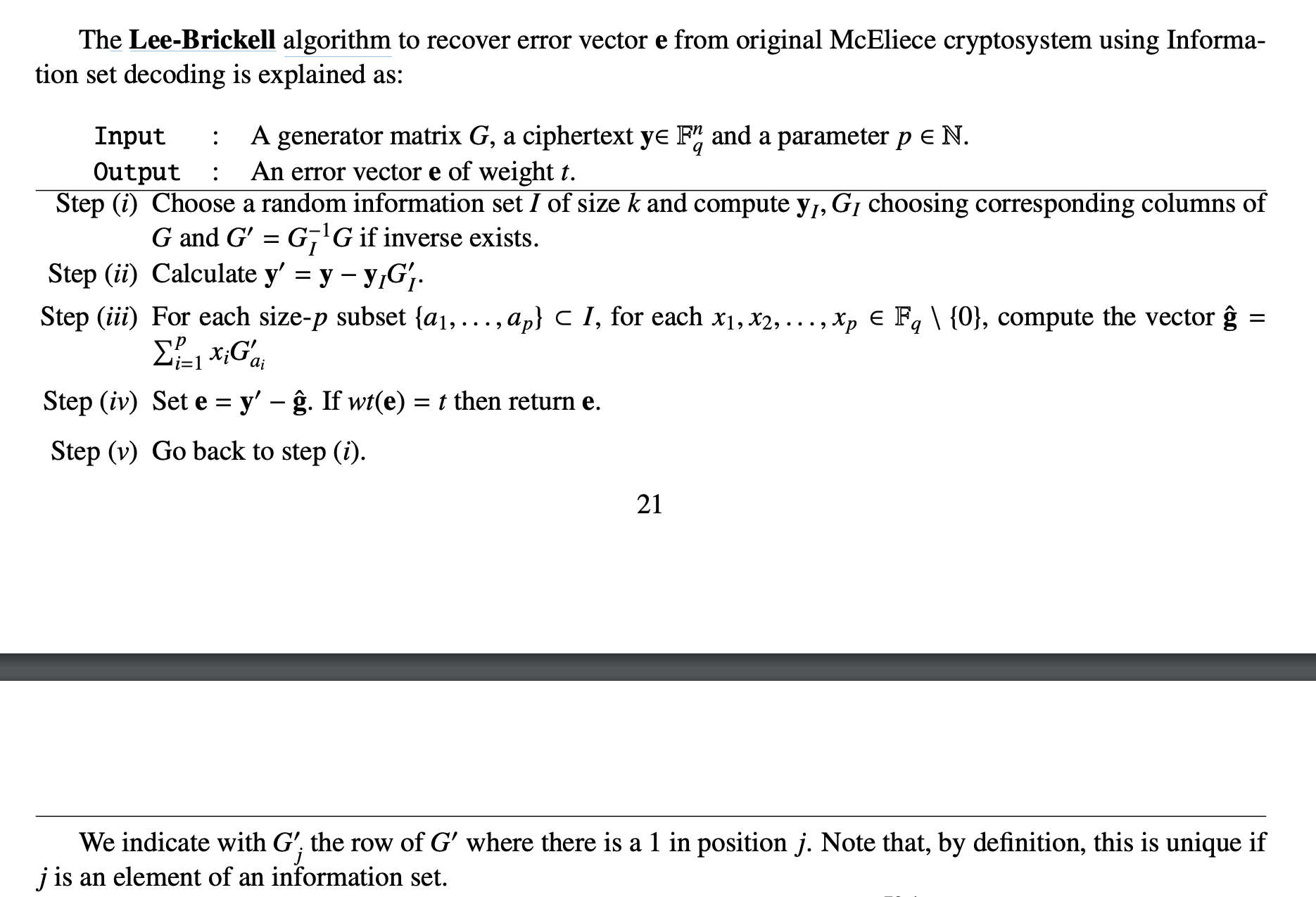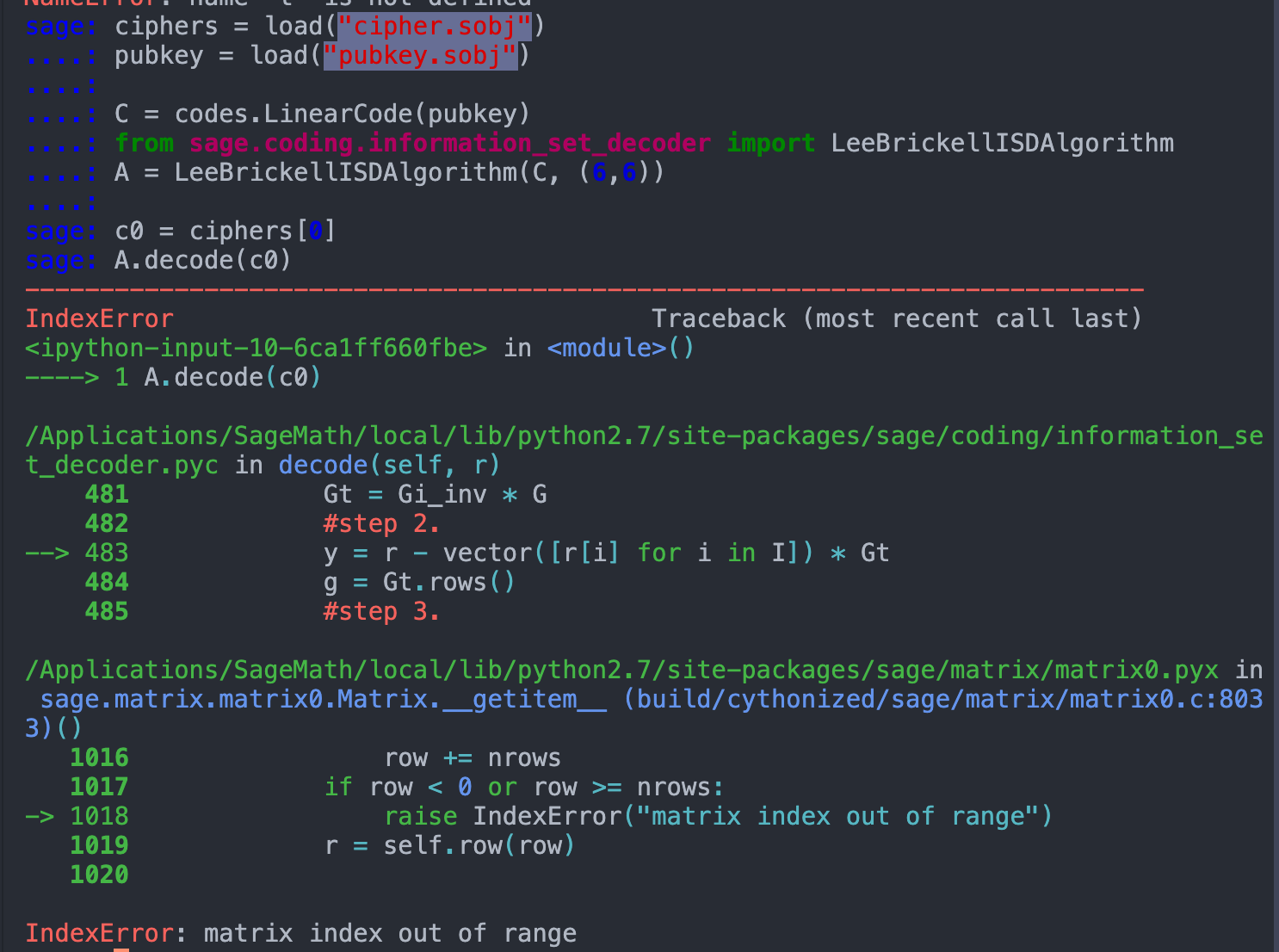makekey函数中,有
$$
\begin{aligned}
(q^2 x)^\frac{p-1}{2} &\equiv q^{p-1} x^\frac{p-1}{2} \equiv (\frac{x}{p})\pmod{p} \newline
(p^2 x)^\frac{q-1}{2} &\equiv p^{q-1} x^\frac{q-1}{2} \equiv (\frac{x}{q})\pmod{q}
\end{aligned}
$$
其中,$(\frac{x}{p})\pmod{p}$表示$x$在$F_p$下的勒让德符号。
要满足
$$
(q^2 x)^\frac{p-1}{2} + (p^2 x)^\frac{q-1}{2} = n - phi - 1 = pq - (pq - p - q + 1) - 1 = (p-1) + (q-1)
$$
只有
$$
\begin{aligned}
(q^2 x)^\frac{p-1}{2} &= p-1 \equiv -1 \pmod{p} \newline
(p^2 x)^\frac{q-1}{2} &= q-1 \equiv -1 \pmod{q}
\end{aligned}
$$
也就是说$x$是在$F_p, F_q$下的二次非剩余(Quadratic Nonresidue)。
加密过程则是对msg的每一bit进行加密:
$$
c \equiv x^{br || bi} \cdot r^2 \pmod{N}
$$
br是一个随机数$r$的二进制表示,bi是msg的某一bit(0或1)。
也就相当于
$$
c \equiv x^{2r + bi} \cdot r^2 \pmod{N}
$$
我们可以来考察这个$c$在$F_p, F_q$下的勒让德符号:
$$
\begin{aligned}
(\frac{c}{p}) \equiv (\frac{x^{2r} x^{bi} r^2 }{p}) \equiv (\frac{x^r}{p})^2 (\frac{x^{bi}}{p}) (\frac{r}{p})^2 \equiv (\frac{x^{bi}}{p}) \pmod{p} \newline
(\frac{c}{q}) \equiv (\frac{x^{2r} x^{bi} r^2 }{q}) \equiv (\frac{x^r}{q})^2 (\frac{x^{bi}}{q}) (\frac{r}{q})^2 \equiv (\frac{x^{bi}}{q}) \pmod{q}
\end{aligned}
$$
msg的这一位bi是0的话,两个勒让德符号肯定都是1;如果这一位bi是1的话,勒让德符号肯定都是-1(p-1或q-1)。
因此可以通过勒让德符号推算出bi,进而得到msg。
给了n和phi,直接利用sagemath的解方程功能就可以拿到p, q。
1
2
3
4
5
6
7
8
9
10
|
# sage 8.9
N = 9433451661749413225919414595243321311762902037908850954799703396083863718641136503053215995576558003171249192969972864840795298784730553210417983714593764557582927434784915177639731998310891168685999240937407871771369971713515313634198744616074610866924094854671900334810353127446778607137157751925680243990905528141072864168544519279897224494849206184262202130305820187569148057247731243651084258194009459936702909655448969693589800987266378249891157940262898554047247605049549997783511107373248462587318323152524969684724690316918761387154882496367769626921299091688377118938693074486325995308403232228282839975697
phi = 9433451661749413225919414595243321311762902037908850954799703396083863718641136503053215995576558003171249192969972864840795298784730553210417983714593764557582927434784915177639731998310891168685999240937407871771369971713515313634198744616074610866924094854671900334810353127446778607137157751925680243990711180904598841255660443214091848674376245163953774717113246203928244509033734184913005865837620134831142880711832256634797590773413831659733615722574830257496801417760337073484838170554497953033487131634973371143357507027731899402777169516770264218656483487045393156894832885628843858316679793205572348688820
var("p q")
print solve([p*q == N, p*q - p - q + 1 == phi], p, q)
# [
# [p == 94130524494940356506875940901901506872984699033610928814269310978003376307730580667234209640309443564560267414630644861712331559440658853201804556781784493376284446426393074882942957446869925558422146677774085449915333876201669456003375126689843738090285370245240893337253184644114745083294361228182569510971, q == 100216711979082556377200124903474313599976321274816484378304672662900171906266478070844182716079881540999761528986068197079878654411887736955737660906283803174161740862819849415729979371880583995409044839777513091451849412985192528374337852907661670174530234397743068706607004213367391908429077794527921775907],
# [p == 100216711979082556377200124903474313599976321274816484378304672662900171906266478070844182716079881540999761528986068197079878654411887736955737660906283803174161740862819849415729979371880583995409044839777513091451849412985192528374337852907661670174530234397743068706607004213367391908429077794527921775907, q == 94130524494940356506875940901901506872984699033610928814269310978003376307730580667234209640309443564560267414630644861712331559440658853201804556781784493376284446426393074882942957446869925558422146677774085449915333876201669456003375126689843738090285370245240893337253184644114745083294361228182569510971]
# ]
|
可以直接求出p,q。
接下来只需要判断每一个c的勒让德符号(欧拉判别法)就可以知道msg的那一位是0还是1了。
1
2
3
4
5
6
7
8
9
10
11
12
13
14
15
16
17
18
19
20
21
22
23
|
# python3
from Crypto.Util.number import long_to_bytes
p = ...
q = ...
def legendre(a, p):
return pow(a, (p-1)//2, p)
ciphers = open("output", "r").readlines()[2]
ciphers = [int(c) for c in ciphers[1:-3].replace("L", "").split(", ")]
msg = ""
for c in ciphers:
lp = legendre(c, p)
lq = legendre(c, q)
if lp == 1 and lq == 1:
msg += "0"
else:
msg += "1"
print(long_to_bytes(int(msg, 2)))
# flag{bd4f1790-f4a2-4904-b4d2-8db8b24fd864}
|
这题比赛结束后的1个半小时,才做出来,总算意识到我是多么菜了。。
没见过这玩意,得现学。。
网上搜了下,直接搜mceliece就能搜到,但是,woc?什么玩意儿???
搜了很多资料,但是都没怎么看得进去。。
有些paper,是建立在你对这个东西已经有一定了解的基础上的。。直接一上来就看,体验的确很差。
也搜到了hack.lu 2017的一道同名题(但是只能找到一个exp):

这个代码,tmd,写得也太烂了吧。。
而且还没题目具体内容,不能抄一波作业。。很难受
后来找到了一篇比较好上手的资料: https://arxiv.org/pdf/1907.12754.pdf
前面两章没怎么仔细看(因为看不太懂。。),直接去看了点第3章。
实际上,这个Mceliece跟GGH很相似。
都是明文msg乘上一个矩阵,线性变换一波,然后加上一点error,让别人很难去解密,只有掌握了trapdoor information的才能去解密。
不同于GGH的解密是利用lattice的good basis, bad basis, Babai's algorithm,这里的解密是利用了纠错码的作用,能够对增添了error的内容进行纠错,得到没有被误扰的结果,然后乘一下逆矩阵就能搞回msg了。
给的pubkey是$G’ = S\cdot G\cdot P$,其中$S$是一个k × k = 28 × 28 的矩阵,$G$是一个k × n = 28 × 64的矩阵,$P$是一个n × n = 64 × 64的矩阵,所以$G’$是一个k × n = 28 × 64的矩阵。
对明文进行了一个分组,每组64bits,进行加密:
$$
c = m \cdot G’ + e
$$
更详细的操作过程:

这一题的Mceliece cryptosystem的问题就出现在他给的参数很小:$n = 2^6 = 64, k = 28, t = 6$
但是直接去爆破的话,找不准要爆的那个目标是很难搞的。
我一开始就想着能不能遍历他所有一开始生成这个crypto = McElieceCryptosystem(n,m,irr_poly);中的irr_poly,不过短暂的分析后,显然是不太现实的:
irr_poly的系数是$GF(2^6)$上的元素,总共有64个,irr_poly是一个多项式,最高次数为6,所以一共有$64^7 = 2^{42}$种可能,虽然有irreducible这个条件,但还是很多。。而且sage的运行速度挺慢的。
那么应该去日他的哪里呢?
那就需要继续看下去:

噢,原来Mceliece的e跟GGH的e差不多啊。。都是被日的突破口(GGH的Nguyen Attack也是从这个e入手的)
上面图片的意思就是说,如果参数太小了的话,这个纠错码的纠错能力t就会很小,然后e(一个1 × n = 1 × 64 的向量)里面最多有t个地方能够取值为1,其他地方必须取值0,否则加密之后就不能纠错回来了。
那么这一题的t = 6,从64里面选6个地方,$C_{42}^6 = 74974368$,也就七千多万种可能,能爆。。。
不过又有很难受的一点就是,他的每一组加密的时候,e是随机取的,也就是说每一组所对应的e是不一样的,而且一共有13组加密。。
不过,如果我们继续再看下去,会发现资料里给了一个算法:Lee-Brickell algorithm:

我们可以尝试着去实现一下这个算法,这样我们就可以直接利用这个算法去找到每一组所对应的e。
不过,这上面写的也挺难理解的。。
首先,什么是information set???
找了一会,终于在上面的19页中间部分找到了他的定义:

也就是抽取$G$(用来编码的generator matrix)的若干列,且抽出来新生成的k × k = 28 × 28矩阵必须得是可逆的。
回到这个算法里,他又冒出来一个参数p????无法理解是怎么取的。。
但是看到算法的step 3的时候,我大概了解到了这个p是多少了。
我们这一题的矩阵是在GF(2)上的,然后step 3里面说for each x1, x2, . . . , xp ∈ Fq \ {0},也就是x ∈ GF(2) \ {0} = {1},那么xp只有1个,所以p = 1。
其实在实现这个算法到step 3的时候,我就不知道怎么继续下去了,然后去google了一个Lee-Brickell algorithm,发现SageMath里面居然是自带这种编码的函数的,而且已经实现好了这个算法!!!SageMath果然神器啊。
http://doc.sagemath.org/html/en/reference/coding/sage/coding/information_set_decoder.html

于是就找到了SageMath相应的源码位置,发现官方实现和我的代码居然有那么一些的神似:

⬆️官方实现 ⬇️我的实现

本来想直接用官方给的函数的,但是运行会报错(后来才发现原来是因为需要vector类型的c0,而非matrix类型的c0,因为load出来的c0 = ciphers[0],是matrix类型的,需要取他的第一行c0[0]得到vector类型,再A.decode(c0[0])才行。。真的是太坑了!!!不,应该是我太菜了,不是那么地熟悉SageMath):

然后,我就对比着官方实现,写好了我自己的实现:
1
2
3
4
5
6
7
8
9
10
11
12
13
14
15
16
17
18
19
20
21
22
23
24
25
26
27
28
29
30
31
32
33
34
35
36
37
38
|
# sage 8.9
ciphers = load("cipher.sobj")
pubkey = load("pubkey.sobj")
n = 64
k = 28
t = 6
F2 = GF(2)
def GetRowVectorWeight(n):
return sum(ZZ(i) for i in n[0])
def lee_brickell(G, y):
while True:
# step 1
I = sample(range(n), k)
y_I = matrix(F2, 1, k) # 1*k
G_I = matrix(F2, k, k) # k*k
for i, col in enumerate(I):
y_I[:, i] = y[:, col]
G_I[:, i] = G[:, col]
if rank(G_I) != k: # has no inverse
continue
invG_I = G_I^-1 # k*k
G_bar = invG_I * G # k*k * k*n = k*n
# step 2
y_bar = y - y_I * G_bar
# step 3
x = F2.list()[1:] # F_2 / {0} = [1]
for ai in range(k): # size-1 subset in I.
g = matrix(x[0] * G_bar[ai])
e = y_bar - g
wt_e = GetRowVectorWeight(e)
# print wt_e
if wt_e == t:
return e
c0 = ciphers[0]
e = lee_brickell(pubkey, c)
|
然后直接代入(被引入了一些error的)密文c0进这个算法,就能求出来这个error。
接着,
$$
c - e = (m \cdot G’ + e) - e = m \cdot G’ = c'
$$
然后乘个逆矩阵就完事了。
所以最后完整的exp:
1
2
3
4
5
6
7
8
9
10
11
12
13
14
15
16
17
18
19
20
21
22
23
24
25
26
27
28
29
30
31
32
33
34
35
36
37
38
39
40
41
42
43
44
45
46
47
48
|
# sage 8.9
ciphers = load("cipher.sobj")
pubkey = load("pubkey.sobj")
n = 64
k = 28
t = 6
F2 = GF(2)
def GetRowVectorWeight(n):
return sum(ZZ(i) for i in n[0])
def lee_brickell(G, y):
while True:
# step 1
I = sample(range(n), k)
y_I = matrix(F2, 1, k) # 1*k
G_I = matrix(F2, k, k) # k*k
for i, col in enumerate(I):
y_I[:, i] = y[:, col]
G_I[:, i] = G[:, col]
if rank(G_I) != k: # has no inverse
continue
invG_I = G_I^-1 # k*k
G_bar = invG_I * G # k*k * k*n = k*n
# step 2
y_bar = y - y_I * G_bar
# step 3
x = F2.list()[1:] # F_2 / {0} = [1]
for ai in range(k): # size-1 subset in I.
g = matrix(x[0] * G_bar[ai])
e = y_bar - g
wt_e = GetRowVectorWeight(e)
# print wt_e
if wt_e == t:
return e
s = ""
for c in ciphers:
e = lee_brickell(pubkey, c) # c = m * pubkey + e
corrected = c - e # m * pubkey = c - e
m = pubkey.solve_left(corrected)
for i in m[0]:
s += str(i)
# print s
print hex(int(s, 2)).strip('0xL').decode('hex')
# flag{c941a3cc-85e3-4401-a0f1-764206e71bf3}
|
后来意识到用官方给的函数为什么会报错的原因后,改用官方的也写了一下exp,居然只需要15行:
1
2
3
4
5
6
7
8
9
10
11
12
13
14
15
16
|
# sage 8.9
ciphers = load("cipher.sobj")
pubkey = load("pubkey.sobj")
C = codes.LinearCode(pubkey)
from sage.coding.information_set_decoder import LeeBrickellISDAlgorithm
A = LeeBrickellISDAlgorithm(C, (6,6))
s = ""
for cipher in ciphers:
corrected = A.decode(cipher[0]) # c = m * pubkey + e ==> c' = m * pubkey
m = pubkey.solve_left(corrected)
s += ''.join(str(i) for i in m)
print hex(int(s, 2)).strip('0xL').decode('hex')
# flag{c941a3cc-85e3-4401-a0f1-764206e71bf3}
|
总结一下,感觉自己还是太菜了啊。。
对于这种未知的东西,总有一种畏惧感??
资料太多了,一时不知道到底怎么看。。现学能力有待提高。
todo: https://crypto.stackexchange.com/questions/15107/mceliece-information-set-decoding-attack-vulnerability/22779#22779
这个proof of work,很眼熟啊,感觉是杭电的师傅出的题。
在"A Friendly Introduction to Number Theory"的第32章有讲过这个pell equation。

意思就是说,如果你找到了这个方程的一个最小(正整数)解,那么你就可以通过一个类似于通项公式的方式递推得到所有的解。
证明的话,嘿嘿嘿,当初我看的时候就没怎么看得懂,似乎是用了一个非常高超的数学证明手法:费马的无穷递降法(Fermat’s method of descent)。。。数论还是很有意思的啊。
但是好在有一个online website能够帮我们解决这种二次的丢番图方程(Diophantine equations): https://www.alpertron.com.ar/QUAD.HTM
(这个网站上面的因数分解功能也很给力,基本280bit以下的都能通过ECM或者Quadratic Sieve在短时间内分解出来)。

这一题中的方程形式是
$$
x^2 - a y^2 = b
$$
其中a, b的取值如下:
1
2
|
a = random.randint(10,50)
b = random.randint(1,2)
|
一共就只有41*2 == 82种可能,但是由于pell equations是在有些情况下是没有解的(b = 2的时候经常会没解),在某些情况下最小解会挺大的,所以服务器给出某一组a, b的时候是有可能无解的。。。
wiki上就给出了在b = 1的时候,最小解的情况,但没有给出递推公式(也可以自己推算一下)(经某位师傅提醒,wiki上实际上是有递推公式的。。)。


在这个神奇的网站
上是有递推公式的,例如a = 24, b = 1的时候,我们可以得到如下结果:

我们可以从x = 1, y = 0这个解(显然这是b==1时都有的一个trivial solution)开始,然后通过
$$
\begin{aligned}
x_{n+1} &= 5 x_n + 24 y_n \newline
y_{n+1} &= x_n + 5 y_n
\end{aligned}
$$
这个递推公式求出后面的所有解。
这一题,只需要给服务器发送150个解就可以了。
但由于是需要nc远程交互的,而且我也没怎么找到那个网站的api,所以就先预先算好一些比较小一点的递归公式,然后当服务器给出的参数与本地相符时,就进行交互,否则,断开重连。
1
2
3
4
5
6
7
8
9
10
11
12
13
14
15
16
17
18
19
20
21
22
23
24
25
26
27
28
29
30
31
32
33
34
35
36
37
38
39
40
41
42
43
44
45
46
47
48
49
50
51
52
53
54
55
56
57
58
59
60
61
62
63
64
65
66
67
68
69
70
71
72
73
74
75
76
77
78
79
80
81
|
import re
from hashlib import sha256
from itertools import product
import time
from pwn import *
context.log_level = "debug"
s = string.ascii_letters + string.digits
while True:
r = remote('39.97.210.182', 61235)
rec = r.recvline().decode()
suffix = re.findall(r'\(XXXX\+(.*?)\)', rec)[0]
digest = re.findall(r'== (.*?)\n', rec)[0]
print(f"suffix: {suffix} \ndigest: {digest}")
print('Calculating hash...')
for i in product(s, repeat=4):
prefix = ''.join(i)
guess = prefix + suffix
if sha256(guess.encode()).hexdigest() == digest:
print(guess)
break
r.sendafter(b'Give me XXXX:', prefix.encode())
rec = r.recvlines(numlines=2)[1].decode()
a = int(re.findall(r'a = ([0-9].*?),', rec)[0])
b = int(re.findall(r'b = ([0-9].*?)', rec)[0])
print(a, b)
if a == 35 and b == 1:
x, y = 1, 0
for _ in range(150):
x, y = 6*x + 35*y, x + 6*y
r.sendline(str(abs(x)).encode())
time.sleep(0.3)
r.sendline(str(abs(y)).encode())
time.sleep(0.3)
elif a == 30 and b == 1:
x, y = 1, 0
for _ in range(150):
x, y = 11*x + 60*y, 2*x + 11*y
r.sendline(str(abs(x)).encode())
time.sleep(0.3)
r.sendline(str(abs(y)).encode())
time.sleep(0.3)
elif a == 24 and b == 1:
x, y = 1, 0
for _ in range(150):
x, y = 5*x + 24*y, 1*x + 5*y
r.sendline(str(abs(x)).encode())
time.sleep(0.3)
r.sendline(str(abs(y)).encode())
time.sleep(0.3)
elif a == 20 and b == 1:
x, y = 1, 0
for _ in range(150):
x, y = 9*x + 40*y, 2*x + 9*y
r.sendline(str(abs(x)).encode())
time.sleep(0.3)
r.sendline(str(abs(y)).encode())
time.sleep(0.3)
elif a == 15 and b == 1:
x, y = 1, 0
for _ in range(150):
x, y = 4*x + 15*y, 1*x + 4*y
r.sendline(str(abs(x)).encode())
time.sleep(0.3)
r.sendline(str(abs(y)).encode())
time.sleep(0.3)
else:
r.close()
continue
r.interactive()
|
sleep(0.3)的原因是,我先在本地测试的时候,发现如果不sleep的话,可能会有客户端发送过快,导致多条内容到了服务端后会变成一条,然后int解析不了。。
invalid literal for int() with base 10: '47525\n9701\n'
最后开了n个终端在跑,跑出来如下:















